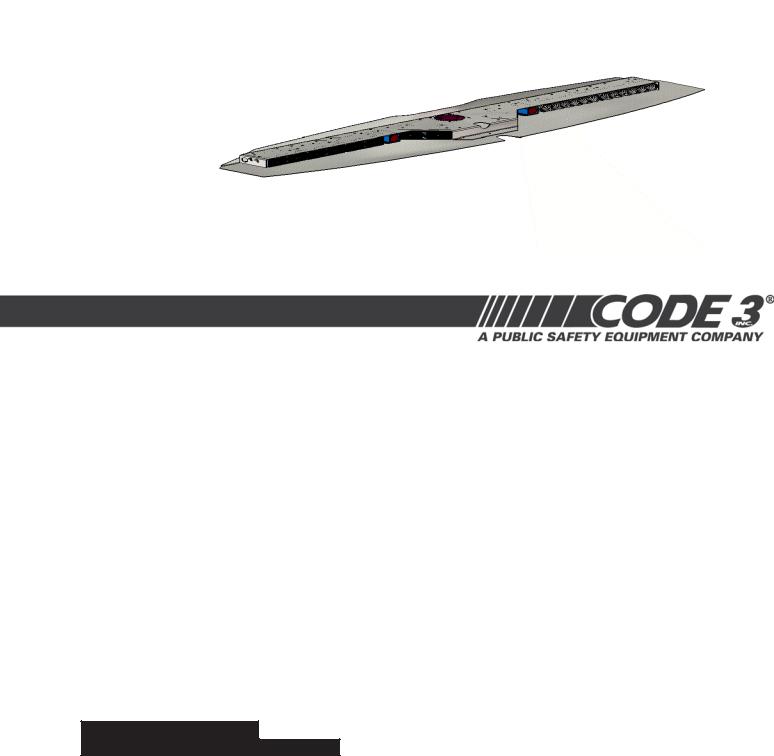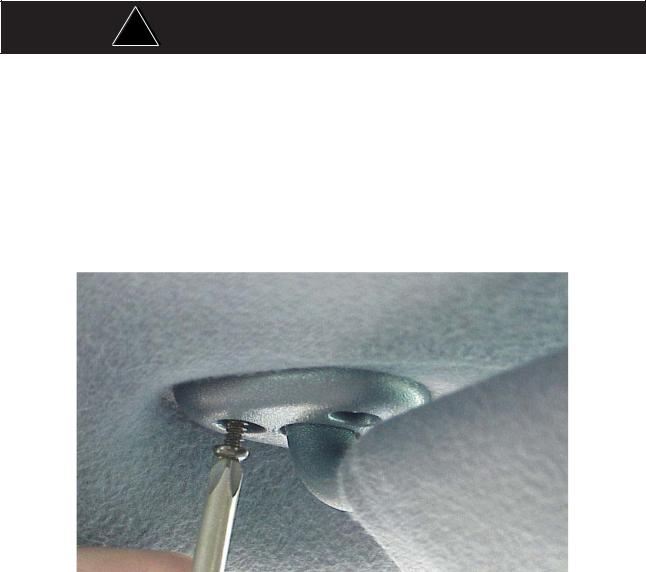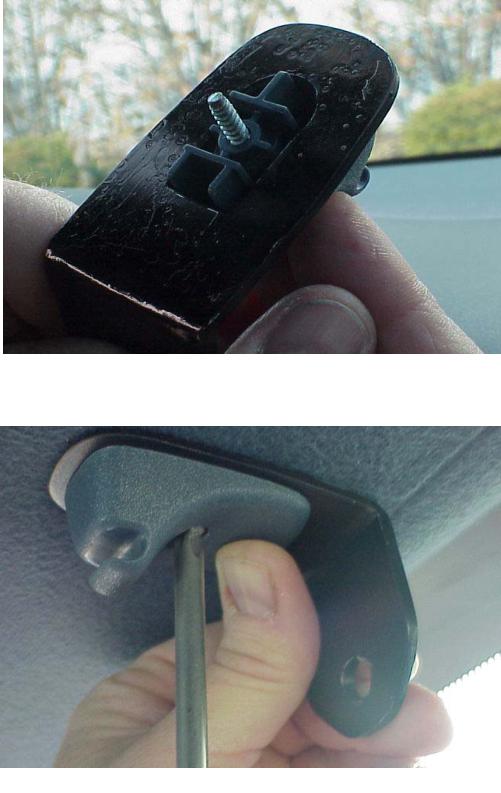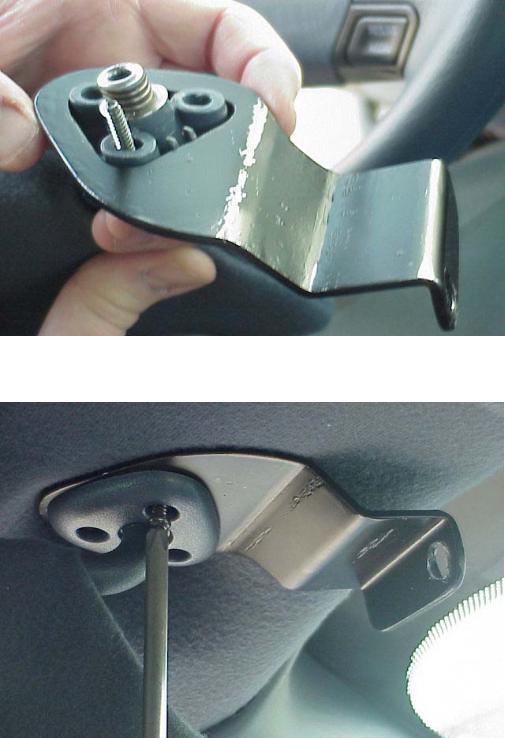Code 3 SuperVisor TL for Chevy Impala User Manual

INSTALLATION &
OPERATION
MANUAL
SUPERVISOR™
SuperVisor™
Interior Lighting System
CHEVROLET IMPALA
CONTENTS: |
|
|
|
Introduction .......................................................................... |
2 |
|
Unpacking & Pre-Installation ............................................... |
3 |
|
Installation & Mounting ..................................................... |
3-7 |
|
Wiring Diagram & Instructions .......................................... |
8-9 |
|
Fusing and MR8 Lamp Installation .................................... |
1 0 |
|
LED Flash pattern selection & Troubleshooting ............... |
1 1 |
|
Exploded View & Parts List .............................................. |
1 2 |
|
Warranty ............................................................................ |
1 6 |
For future reference record your product's serial no. here __________________________________________ |
|
|
IMPORTANT: INSTALLER: |
This manual must be delivered to the end user of this equipment. |
|
Read all instructions and warnings before installing and using. |
|
|

Introduction
The SuperVisor™ is an interior lighting system that fits in the visor area near the top of the windshield. It delivers an amazing warning signal, including MR8 powered takedown lights.
The SuperVisor is designed on a modular basis, which means that the light bar can be customized to meet most any requirements. The SuperVisor has room for up to eight LED lightheads plus two MR8 takedowns. Each lighthead is individually wired for any flash pattern or combination of flash patterns required.
The use of this or any warning device does not ensure that all drivers can or will observe or react to an emergency warning signal. Never take the right-of-way for granted. It is your responsibility to be sure you can proceedsafelybeforeenteringanintersection,drivingagainsttraffic,respondingatahighrateofspeed, or walkingonoraroundtrafficlanes.
The effectiveness of this warning device is highly dependent upon correct mounting and wiring. Read and follow the manufacturer’s instructions before installing or using this device. The vehicle operator should insure daily that all features of the device operate correctly. In use, the vehicle operator should insure the projection of the warning signal is not blocked by vehicle components (i.e.: open trunks or compartment doors), people, vehicles,orotherobstructions.
This equipment is intended for use by authorized personnel only. It is the user’s responsibility to understand and obey all laws regarding emergency warning devices. The user should check all applicable city, state and federallawsandregulations.
Code 3, Inc., assumes no liability for any loss resulting from the use of this warning device.
Properinstallationisvitaltotheperformanceofthiswarningdeviceandthesafeoperationoftheemergency vehicle. It is important to recognize that the operator of the emergency vehicle is under psychological and
!physiological stress caused by the emergency situation. The warning device should be installed in such a manner as to: A) Not reduce the output performance of the system, B) Place the controls within convenient
WARNING! reach of the operator so that he can operate the system without losing eye contact with the roadway. Emergency warning devices often require high electrical voltages and/or currents. Properly protect and use
caution around live electrical connections. Grounding or shorting of electrical connections can cause high current arcing, which can cause personal injury and/or severe vehicle damage, including fire.
Anyelectronicdevicemaycreateorbeaffectedbyelectronmagneticinterference.Afterinstallationofany electronicdeviceoperateallequipmentsimultaneouslytoinsurethatoperationisfreeofinterference.Never power emergency warning equipment from the same circuit or share the same grounding circuit with radio communicationequipment.
PROPER INSTALLATION COMBINED WITH OPERATOR TRAINING IN THE PROPER USE OF EMERGENCY WARNING DEVICES IS ESSENTIAL TO INSURE THE SAFETY OF EMERGENCY PERSONNEL AND THE PUBLIC.
All devices should be mounted in accordance with the manufacturer's instructions and securely fastened to vehicleelementsofsufficientstrengthtowithstandtheforcesappliedtothedevice.Driverand/orpassenger airbags (SRS) will affect the way equipment should be mounted. This device should be mounted by permanent installationandwithinthezonesspecifiedbythevehiclemanufacturer,ifany.Anydevicemountedinthe deployment area of an air bag will damage or reduce the effectiveness of the air bag and may damage or dislodge the device. Installer must be sure that this device, its mounting hardware and electircal supply wiring does not interfere with the air bag or the SRS wiring or sensors. Mounting the unit inside the vehicle by a method other than permanent installation is not recommended as unit may become dislodged during swerving, sudden braking or collision. Failure to follow instructions can result in personal injury.
2

Unpacking & Pre-installation
Carefully remove the SuperVisor™ and place it on a flat surface, taking care not to scratch the lenses or damage the cable coming out of the side. Examine the unit for transit damage, broken lamps, etc. Report any damage to the carrier and keep the shipping carton.
Standard light bars are built to operate on 12 volt D.C. negative ground (earth) vehicles. If you have an electrical system other than 12 volt D.C. negative ground (earth), and have not ordered a specially wired light bar, contact the factory for instructions.
Test the unit before installation. To test, touch the black, (and if present grey, purple, and brown) wire(s) to the ground (earth) and the other wires to +12 volts D.C., in accordance with the instructions attached to the cable (an automotive battery is preferable for this test). A battery charger may be used, but please note that some electronic options (flashers, stingrays, etc.) may not operate normally when powered by a battery charger. If problems occur at this point, contact the factory.
Installation & Mounting
WARNING! |
! |
Utilizing non-factory supplied screws and/or mounting brackets and/or the improper number |
of screws may result in loss of warranty coverage on the equipment. |
Mounting Hardware - All mounting hardware is packed in a small box inside the main carton. There are four brackets used to mount the visor bar to the vehicle. These are discussed in detail later.
Removing Sun Visors
Begin the installation by removing the Chevrolet Impala's driver and passenger sun visors. Identify each visor with tape or other marking to indicate the driver from the passenger side unit. They are not identical. There are three screws that hold the pivotal arm of the sun visor to the headliner. Remove the two outer screws using a small torx screwdriver. Then unclip the sun visor and rotate it over to expose the last screw as shown in Figure 1.
FIGURE 1
3

Attach brackets to sun visor retaining clips
In order to remove the sun visor retaining clip, unscrew the one torx screw holding it in place. Place the inner bracket on the retaining clip as shown in Figure 2. Attach the inner bracket and retaining clip to the headliner as illustrated in Figure 3. Do not completely tighten the screw at this time.
FIGURE 2
FIGURE 3

4

Attaching the pivot arm brackets
Attach the outer brackets that are supplied noting the difference between passenger and driver side brackets. Position the driver's side bracket on the driver's side sun visor's pivot arm as shown in Figure 4. Attach the driver's side bracket to the headliner with the inner torx screw as shown in figure 5. Next, move the sun visor over to gain access to install the other two torx screws. Do not tighten the screws at this time. Repeat the same proceedure to attach the passenger's side outer bracket.
FIGURE 4
FIGURE 5
5
